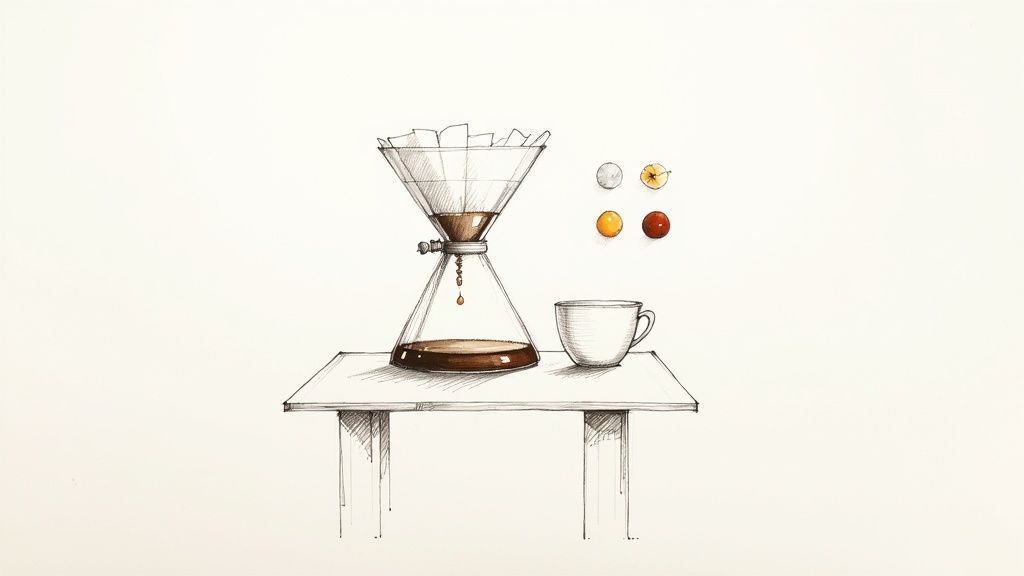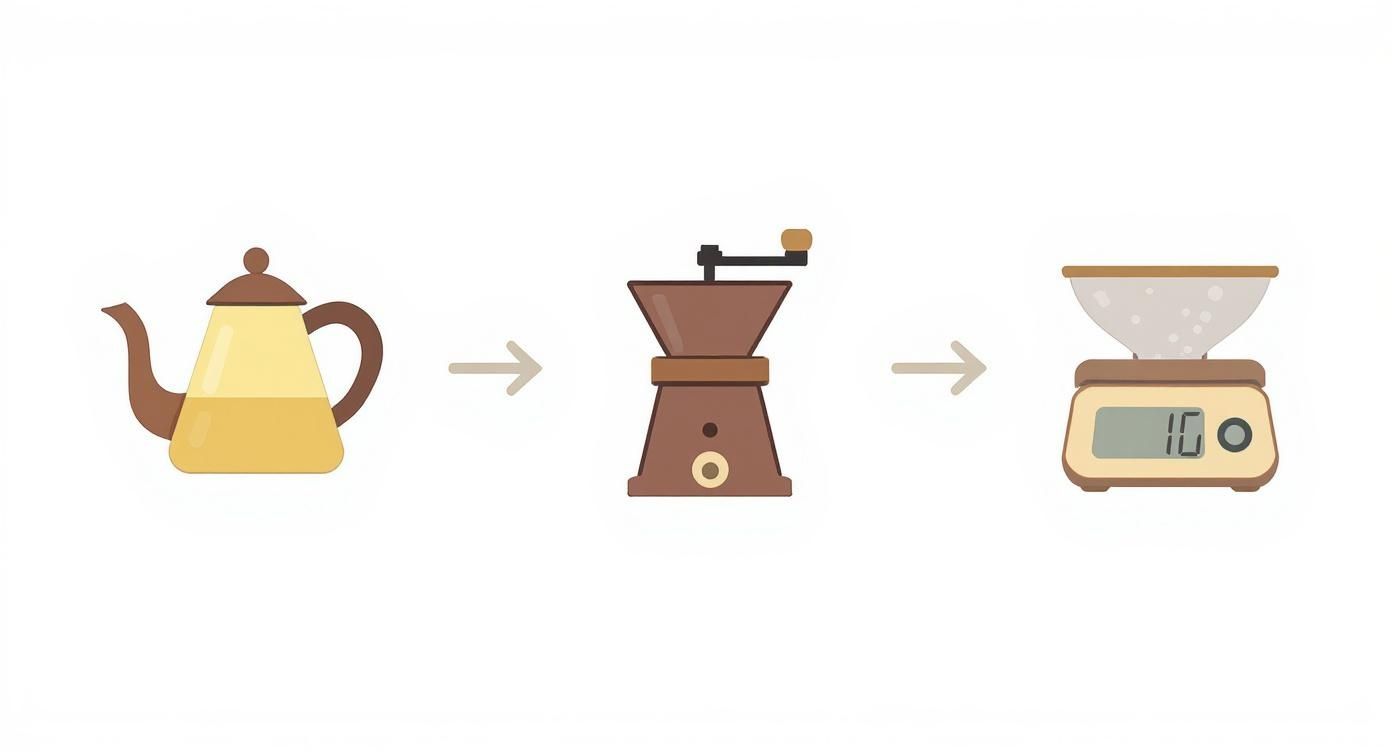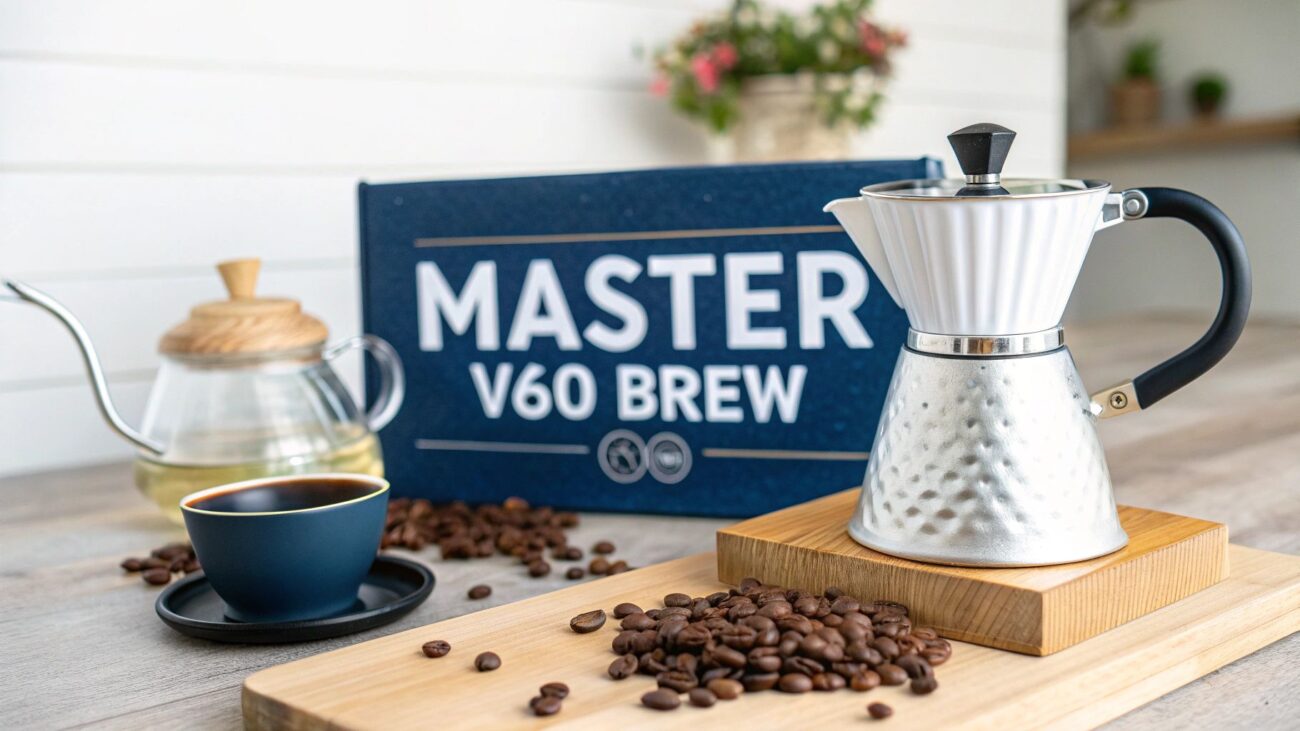How to brew with chemex: The ultimate guide

To brew with a Chemex is to chase an exceptionally clean, bright, and flavourful cup of coffee. It’s a brew often described as tea-like in its clarity, and for good reason. This simple yet elegant pour-over method uses a uniquely thick, bonded paper filter that strips away oils and sediment, allowing the delicate notes of high-quality beans to take centre stage. It’s a process celebrated for its ability to produce a pure and nuanced brew.
Why The Chemex Is a UK Favourite
The Chemex has become something of an icon in the UK's speciality coffee scene. Its timeless hourglass design, complete with a polished wood collar and leather tie, isn’t just for show. It’s a piece of functional art that’s earned a permanent spot in museums and design-conscious kitchens alike.
But its popularity is built on far more than just good looks. The real magic lies in how you brew with a Chemex, a method that champions clarity and precision above all else. This approach has resonated deeply with UK coffee lovers who are increasingly drawn to the nuanced world of single-origin beans.
The Signature Chemex Profile
The secret to that signature Chemex taste is its proprietary bonded filters. They are substantially thicker than your standard paper filters, a design choice that profoundly impacts the final cup.
- Exceptional Clarity: The dense filter paper traps almost all coffee oils (lipids) and fine sediment, resulting in a brew that is remarkably clean and free from bitterness.
- Bright and Nuanced Flavour: By removing the oils that can muddy flavour profiles, the Chemex allows the subtle, bright, and often fruity or floral notes of speciality coffee to shine through.
- Light Body: The resulting coffee has a delicate, almost tea-like body, making it incredibly smooth and easy to drink.
At Seven Sisters, we find the Chemex is the perfect brewer for showcasing the delicate character of our single-origin roasts. It reveals layers of flavour that other methods might obscure, making it a true connoisseur's choice.
This unique profile has fuelled its growth across the country. As more UK coffee drinkers explore what is specialty coffee and seek purer taste experiences at home, the Chemex has become a go-to. Market insights show a significant rise in its adoption, with retailers reporting a 15% year-on-year increase in Chemex sales as the brewer finds its place in independent cafés and home coffee bars. This surge reflects a collective shift towards appreciating coffee in its most refined form.
Assembling Your Perfect Chemex Setup
Before a single drop of water even thinks about touching the coffee grounds, brewing a truly exceptional Chemex starts with your equipment. Getting your setup right isn't just about ticking boxes; it's the foundation for a delicious, repeatable brew. Trying to skip these essentials is like baking a cake without measuring spoons—you might get something that resembles a cake, but you're leaving far too much to chance.
The heart of it all is, of course, the Chemex brewer itself. These beautiful glass carafes come in various sizes, from a neat three-cup model that’s perfect for one, all the way up to a ten-cup version for when you have company. Paired with the brewer, the proprietary Chemex bonded filters are completely non-negotiable. They are much thicker than your average filter paper, and that’s the secret to getting that famously clean, sediment-free cup.
The Non-Negotiable Trio
While the brewer and filters get you started, there are three other pieces of kit that will take your coffee from just good to consistently brilliant. Investing in these tools gives you the control you need to really dial in your technique.
- A Quality Burr Grinder: Pre-ground coffee goes stale fast, losing all those lovely aromatic compounds. A burr grinder is a game-changer because, unlike a blade grinder, it crushes beans to a uniform size. This is absolutely critical for an even extraction and a balanced flavour.
- A Gooseneck Kettle: That slow, precise pour you need for a Chemex is almost impossible without one. The long, curved spout gives you total command over the water's flow rate and where it lands, ensuring all the grounds get saturated evenly.
- Digital Scales: Let's be honest, guessing your coffee-to-water ratio is a recipe for disappointment. A good set of digital scales, measuring to at least a tenth of a gramme, lets you be exact. It's how you replicate that perfect cup, day in and day out.
To complete your setup, you can find a curated selection of our team's favourite brewing tools among our coffee making accessories.
The real beauty of the Chemex lies in its ability to highlight subtlety. That thick paper filter is designed to remove most of the coffee oils and sediment, producing a brighter, cleaner cup that lets the delicate flavours of high-quality beans really sing.
This clean profile is a perfect match for the UK’s growing love for light-to-medium roasts and interesting single-origin coffees. The UK market for Chemex brewers, now valued at around £1.2 million, is a clear sign of this trend. In fact, sales are projected to grow by 8% annually over the next five years as more home brewers discover its unique character. You can read more insights on the UK’s demand for better coffee from stylecafe.co.uk. With the right gear in hand, you are ready to unlock that potential.
Mastering The Chemex Pour Over Technique
With all your gear ready and your Seven Sisters coffee beans freshly ground, it’s time to get to the heart of the matter—the brew itself. The pouring technique is what turns great ingredients into a truly memorable cup of coffee. Think of it as a quiet, meditative process that rewards a bit of patience and precision with incredible flavour and clarity.
This is where the magic really happens when you brew with a Chemex. We’ll walk you through our repeatable method, breaking down each part of the process, from warming up the brewer to that final, satisfying drip. Following these steps is the key to achieving that signature clean, bright profile every single time.
This flow chart gives you a quick look at the key equipment you’ll need for a successful brew.
As the visual shows, the essential trio for precision brewing is a gooseneck kettle for control, a quality grinder for consistency, and scales for accuracy. Get these three things right, and you've built the foundation for a perfect pour-over.
Preparing The Brewer And Filter
First things first: get your water heating up. You’re aiming for a temperature somewhere between 92-96°C. If you don’t have a fancy temperature-controlled kettle, no worries. Just bring the water to a boil and then let it stand for about 30-45 seconds to cool down just a touch.
Next, grab a Chemex bonded filter and place it into the top of your brewer. Make sure the side with the three layers is sitting against the pouring spout. This isn't just a random design choice; it’s a clever feature that stops the filter from collapsing and blocking the air channel as you pour.
With the filter in place, give it a really good rinse with some of your hot water. This step is non-negotiable for two big reasons:
- It washes away any papery taste from the filter, making sure it doesn't taint the delicate flavours of your coffee.
- It pre-heats the glass carafe, which is vital for keeping a stable brewing temperature from start to finish.
Just remember to carefully pour out the rinse water before you add your coffee grounds!
The Bloom: The Key To A Flavourful Start
Now that your brewer is prepped and ready, tip your freshly ground coffee into the filter. Give it a gentle shake to level the grounds into a nice, flat bed. Pop the whole setup onto your digital scales and press the tare button to zero it out. This is where your attention to detail really starts to pay off.
It's time. Start your timer and begin the bloom. This is just a small, initial pour of water that’s meant to evenly saturate all of the coffee grounds. Using a slow, circular motion, pour in about double the weight of water to coffee—for instance, 60g of water for 30g of coffee.
You'll see the coffee bed swell up and bubble as you pour. That’s carbon dioxide, a gas that gets trapped inside the beans during the roasting process, making its escape. Letting the coffee bloom for 30-45 seconds is so important because it gets rid of that CO2, which would otherwise repel water and lead to an uneven, disappointing extraction.
"The bloom is arguably the most important part of the pour. It prepares the coffee bed for an even extraction, preventing sour or weak flavours. Skipping it is like trying to bake a cake without preheating the oven—you just won't get the best results."
Executing The Main Pour
Once the bloom has worked its magic, it's time for the main pour. The name of the game here is slow, steady, and controlled. You want to apply the water gently to make sure every single coffee ground is extracted evenly.
Start pouring the rest of your water in gentle, concentric circles, beginning at the centre and spiralling your way outwards. Try to avoid pouring water directly down the sides of the paper filter. You'll also want to keep the water level safely below the rim of the Chemex to prevent any messy overflows.
You can do this in one long, continuous pour or break it up into a few smaller pours, often called "pulses." Honestly, both methods work just fine, but many people find that pulse pouring gives them a bit more control over the final brew time. Aim to have all your water poured in by the 2:30 to 3:00 minute mark.
While this guide is all about the Chemex, many of the core principles of pour-over are universal. If you're keen to see how these techniques apply to other brewers, this helpful Hario V60 pour over brewing guide is a great resource. We also have our own guide to the V-60 which offers insights that can benefit any pour-over fan, detailing specific techniques for your V-60 pour-over.
After all the water is in, just let the coffee finish dripping through the filter. This final stage is called the drawdown. All in all, your total brew time should land somewhere between 3:30 and 4:30 minutes. Once the stream of coffee slows to just an intermittent drip, you're done. Lift out the filter, give the Chemex a gentle swirl to mix everything together, and pour yourself a perfect cup.
Troubleshooting Common Chemex Brewing Issues
Even when you follow a recipe to the letter, some brews just don't hit the mark. Don't sweat it—it happens to the best of us. Learning to taste your coffee, diagnose what went wrong, and fix it is what separates a good home brewer from a great one. Think of a disappointing cup not as a failure, but as direct feedback from the beans themselves.
Every brew tells you a story about your technique. By paying close attention to what you're tasting, you can figure out exactly which variable needs a little tweak. Whether it's unpleasantly bitter, disappointingly sour, or just a bit weak and watery, there’s almost always a simple fix.
My Coffee Tastes Bitter or Harsh
If you take a sip and your face scrunches up from a dry, harsh, or intensely bitter flavour, you’re tasting over-extraction. This is what happens when water hangs around the coffee grounds for too long, pulling out all the desirable flavours and then starting on the unpleasant, bitter compounds that are left.
More often than not, the culprit is a grind size that’s simply too fine. Picture water trying to flow through fine sand versus coarse gravel—the finer the grind, the slower the water drains, which massively increases the contact time.
Here's how to sort it out:
- Go coarser on the grind. This is your number one tool for controlling extraction. Adjust your grinder one or two clicks coarser and try again. It's the first and most effective change you can make.
- Mind your temperature. Water that’s scorching hot can also easily over-extract coffee. Make sure your kettle is sitting in that sweet spot between 92-96°C. If you boil and wait, maybe give it an extra 15 seconds to cool down next time.
A bitter brew is a tell-tale sign of over-extraction. The quickest and most effective fix is to coarsen your grind. This allows water to flow through the coffee bed more freely, reducing contact time and stopping those bitter notes from overwhelming your cup.
My Coffee Tastes Sour or Weak
On the other side of the coin, you have coffee that tastes sour, thin, or even a bit like unripe fruit. This is a classic symptom of under-extraction. The water just hasn't had enough time to dissolve all the sweet, balanced flavours from the grounds, leaving you with a hollow-tasting cup.
This is usually the exact opposite of a bitter brew: your grind is too coarse. The water rushes through the coffee bed so quickly that it doesn't have a chance to do its job properly. A brew finishing in under three minutes is a dead giveaway.
To get more flavour out of your beans, you need to increase extraction:
- Go finer on the grind. Nudging your grinder to a slightly finer setting will slow the water down, giving it more time to extract all that lovely sweetness.
- Pour with more care. Make sure you're gently saturating all the grounds, especially around the edges. If your pour is inconsistent, you can create "channels" where water bypasses most of the coffee, resulting in a weak brew.
- Check your water temp. Water that's too cool just doesn't have the energy to pull out the complex flavours locked inside the bean. For a deeper dive, our guide on the best water temperature for coffee has all the details.
Brew Time Is Too Fast or Too Slow
Your total brew time is the most reliable clue you have about extraction. For a typical Chemex brew, you're aiming for a total drawdown time of around 3:30 to 4:30 minutes.
If your brew is gushing through in under 3 minutes, your grind is definitely too coarse. If it’s still dripping away past the five-minute mark, your grind is too fine. Use the timer on your scales as your guide and adjust your grind size to land in that ideal window.
Keep in mind that different beans behave differently. A very dense, light-roast Ethiopian coffee will need a different grind setting than a more porous medium-roast Colombian to hit that same brew time.
Chemex Troubleshooting Quick Fixes
Sometimes you just need a quick reference to figure out what's gone wrong. This table breaks down common taste issues and shows you exactly how to adjust your technique to get that perfect cup.
| Problem (Taste Profile) | Likely Cause | Primary Solution | Secondary Adjustment |
|---|---|---|---|
| Bitter, harsh, astringent | Over-extraction | Make your grind coarser | Lower your water temperature slightly |
| Sour, thin, acidic | Under-extraction | Make your grind finer | Ensure water temperature is hot enough (92-96°C) |
| Watery, weak, no flavour | Under-extraction / Channelling | Make your grind finer | Improve your pour technique for even saturation |
| Muddy, gritty, heavy | Grind is too fine, creating sediment | Make your grind coarser | Check your grinder for burr alignment or wear |
Think of this table as your go-to cheat sheet. By connecting what you taste in the cup to a specific brewing variable, you'll be dialling in your Chemex like a pro in no time.
Caring For Your Chemex And Pairing Your Coffee
A great coffee experience doesn't just stop when the final drop lands in the carafe. The last few steps—tasting, pairing, and cleaning up—are just as important for appreciating the effort you've put into your Chemex brew. Good aftercare keeps your equipment in top shape, and the right food pairing can take the coffee itself to a whole new level.
Because the Chemex gives you such a stunningly clean, bright cup, it’s brilliant at showing off the subtle tasting notes in different roasts. This clarity lets you explore the world of coffee with incredible detail, turning every brew into a mini tasting session right in your kitchen.
Tasting Notes And Perfect Pairings
The unique filtration of the Chemex paper really makes specific flavours in our Seven Sisters roasts sing. It strips away oils that can sometimes muddy delicate notes, letting the true personality of the bean shine through.
- For Fruity & Floral Beans: When you're brewing our light-roast Ethiopian Yirgacheffe, you'll get these bright, vibrant notes of lemon zest, bergamot, and jasmine. The Chemex method gives it an almost tea-like body that’s incredibly refreshing. This is perfect with a light breakfast pastry, like a simple croissant or an almond tart.
- For Rich & Chocolatey Beans: With a medium-roast Colombian, the Chemex will pull out smooth notes of milk chocolate, toasted nuts, and just a hint of caramel. It creates a beautifully balanced cup with an unbelievably clean finish. Try this one with a square of good quality dark chocolate to really double down on that richness.
A pristine Chemex is non-negotiable for flavour purity. Coffee oils are stubborn and will build up over time, eventually turning rancid. When they do, they'll impart a stale, bitter taste to every brew you make, no matter how perfect your technique is.
Keeping Your Chemex Sparkling Clean
Luckily, maintaining your Chemex is refreshingly simple. After each use, just get rid of the filter and grounds, then give the carafe a good rinse with hot water. For a deeper clean to tackle any stubborn oil build-up and stop stains from forming, you’ll need to put in a tiny bit more effort.
At least once a week, take off the wooden collar and leather tie. Grab a bottle brush and a bit of washing-up liquid to scrub the inside of the glass, paying close attention to the bottom where oils tend to gather. Rinse it really well with hot water and let it air dry completely. For any tough stains, a mixture of vinegar and water or a specialised coffee equipment cleaner will bring back its sparkle.
Sustainability And Smart Storage
Your coffee ritual can easily be a sustainable one, too. Used coffee grounds are fantastic for your garden; they add nitrogen-rich organic matter to the soil. Just chuck them in your compost bin. The unbleached Chemex paper filters are also fully compostable.
Of course, storing your beans properly is just as vital as cleaning your brewer. To keep them fresh and protect all those delicate flavours you've worked so hard to extract, have a look at our guide on finding the best coffee storage containers. When you combine meticulous cleaning with smart storage, you're setting yourself up for a perfect cup, every single time.
Got Questions About Your Chemex Brew?
Even with the best instructions, you're bound to run into a few questions as you get the hang of your Chemex. It happens to everyone. To help you along, we’ve put together some quick answers to the questions our team at Seven Sisters hears most often.
Can I Get Away With a Standard Kettle Instead of a Gooseneck?
While you can technically use a standard kettle, you’ll be fighting an uphill battle. A gooseneck kettle isn’t just for show; it’s all about control. That long, slender spout is key to a great Chemex brew because it lets you dictate the speed and placement of the water with incredible precision.
With a standard kettle, the wide spout sends water rushing out, making a gentle, controlled pour almost impossible. This usually leads to uneven saturation of the coffee grounds, which means you'll get a brew that's both over and under-extracted at the same time—and nobody wants that.
White vs. Natural Chemex Filters: Does It Really Matter?
The only real difference is that the white ones have been bleached. They use an oxygen-bleaching process, which leaves you with a completely neutral paper. The natural filters skip that step, which is why they have that light brown colour.
We’re big advocates for the white, bleached filters. While the natural ones work just fine, they can sometimes add a subtle papery or woody taste to your coffee if you don't give them an exceptionally thorough rinse. The white filters guarantee nothing gets between you and the pure flavour of the coffee.
Is It Okay to Use Pre-Ground Coffee for a Chemex?
For the best possible flavour, fresh is always the way to go. The moment coffee is ground, it starts losing the delicate aromatic compounds that make it so vibrant. Grinding your beans just before you brew with a Chemex is probably the single biggest upgrade you can make to your coffee game.
Using your own burr grinder unlocks the full potential of the beans. It also gives you the freedom to tweak the grind size to nail that perfect extraction—something you simply can't do when you buy it pre-ground.
Ready to put this all into practice? Explore our range of exceptional single-origin beans and signature blends, all roasted with care for brewers like you. Find your new favourite at Seven Sisters Coffee Co and discover what a difference freshly roasted, high-quality coffee can make.







